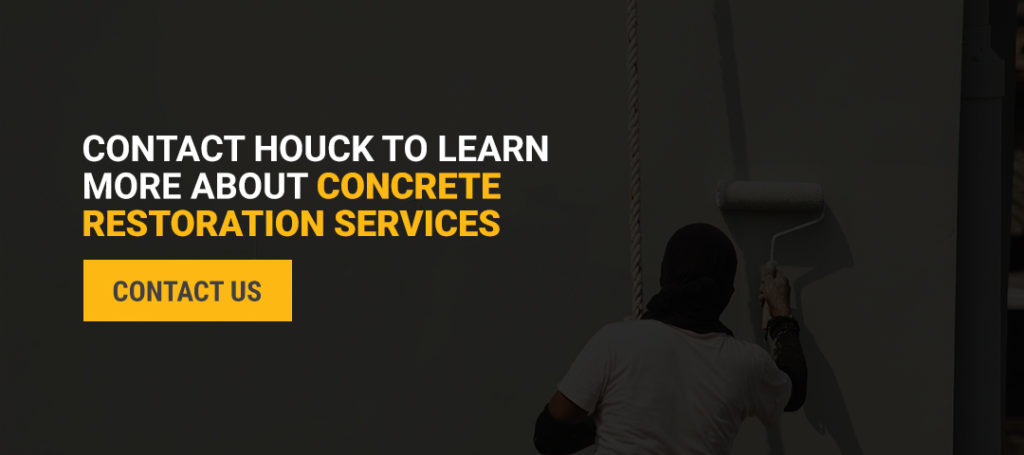Do I Need Concrete Restoration Services?
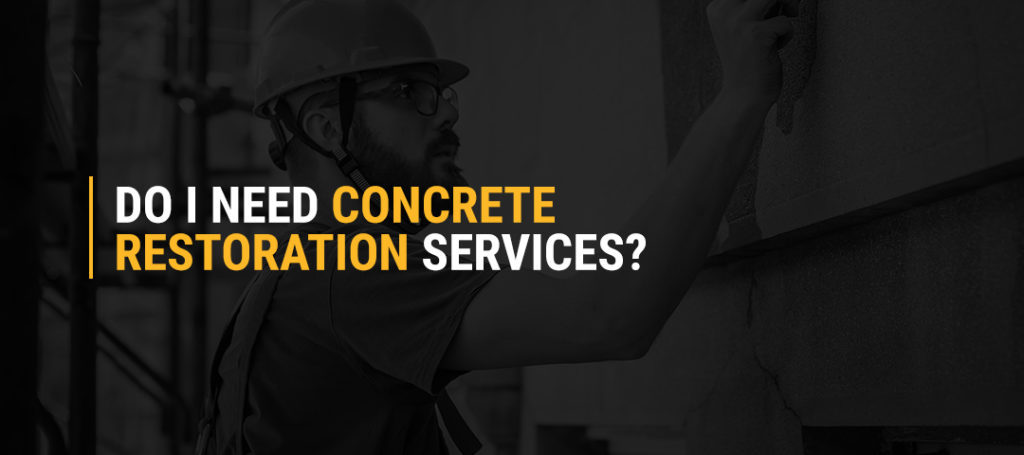
Concrete is a strong, versatile material, but it’s not indestructible. Damage and natural wear or erosion break concrete down over time, leaving behind markings and structural changes that become an eyesore or even a safety hazard. When this happens, you typically have three options — repair, replace or restore your concrete structure or surface. Because replacements can be costly and complex, professional repair and restoration should be your first choice for minor and moderate-level damage.
Unlike concrete repair, concrete restoration corrects both damage and appearance. Your concrete restoration contractor will take the necessary steps to return your concrete surface or structure to its former functionality, strength and style, free of cracks, fading, stains or other issues.
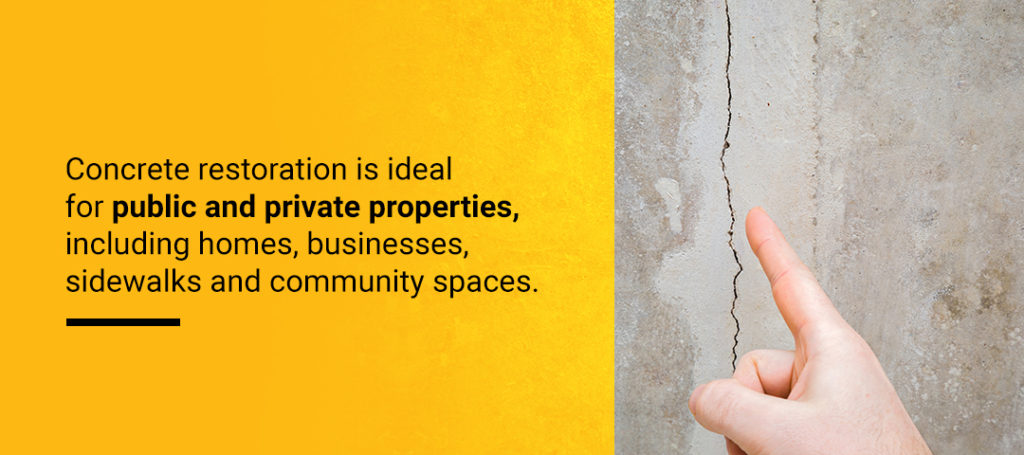
Why Is Concrete Restoration Necessary?
Concrete restoration is ideal for public and private property, including homes, businesses, sidewalks and community spaces. By addressing your concrete concerns early, you may avoid potentially challenging concrete replacement — a complex process that may put your structure or surface out of commission for a few days. Proactive restoration is critical for managing costs and keeping your concrete’s function intact. It’s also the best method for keeping your concrete safe and presentable. Concrete with extensive damage threatens pedestrians and may weaken your structure or platform’s support.
Restored Concrete Extends Longevity
Concrete can last anywhere from 50 to 100 years — sometimes longer — but regular restoration can help extend its lifespan and prevents premature aging or deterioration. Preventive maintenance can address minor cracks, scuffs and buckling before they turn into more significant damages. This longevity is crucial for buildings and structures that rely on concrete supports or foundations. It’s also more cost-efficient to maintain your concrete over time instead of waiting for larger issues to develop — especially when those issues could threaten people, property and connected structures.
Restored Concrete Enhances Safety
Damaged or aging concrete can be hazardous for pedestrians and vehicles in applications like public walkways, patios, driveways and parking garages. It’s especially dangerous when supports or foundations for buildings and structures start deteriorating.
By restoring your concrete, you’re creating a safer environment and minimizing the risk of:
- Slipping: Worn concrete loses its natural traction, which can create slick surfaces for cars and people. Restoration can help revitalize your concrete’s slip-resistance before things like standing water, snow and ice worsen the problem.
- Tripping: Popouts, potholes, cracks, raised edges, holes and chips create an uneven surface that can cause pedestrians to trip. In extreme cases, it can even cause vehicular damage. It also renders the area impassable for wheelchairs, walkers, strollers and other mobility devices that create an equal environment for patrons or employees.
- Instability: Unstable concrete can buckle or become uneven, usually a result of weight overload. This could have devastating results for structural concrete, causing expensive and harmful damage and creating an unsafe environment. Weakened concrete is also more susceptible to impact or erosion.
| Contact Us | Call Us |
Restored Concrete Is More Attractive
For commercial property owners, maintaining a clean, professional appearance is a critical part of managing your building or facility. Over time, concrete may lose its vitality and color from:
- UV fading from sunlight.
- Chemical and acid discoloration.
- Stains and spills from oil, food, and debris.
- Scuffs and tire marks.
- Anti-ice salts near roadways and sidewalks.
Since fading happens at an uneven rate, your concrete may eventually look patchy or become textured in some areas.
Restored Concrete Improves Insulation
Concrete walls, expansion joints, and concrete flooring possess natural thermal resistance that increases your facility’s R-value. Concrete traps heat, so it helps prevent heat loss in buildings. It can also reduce excess indoor moisture that may seep through, creating a more comfortable environment. Low-density concrete tends to have a higher R-value than high density.
These insulating properties are compromised when concrete begins to deteriorate. Once-trapped moisture and air can enter the building, increasing energy costs and decreasing efficiency. If left unrestored, the problem will worsen until it becomes impossible to ignore.
Restored concrete can improve insulation and avoid these complications by ensuring each surface and joint is structurally sound. Regular preventive inspections can help keep them that way.
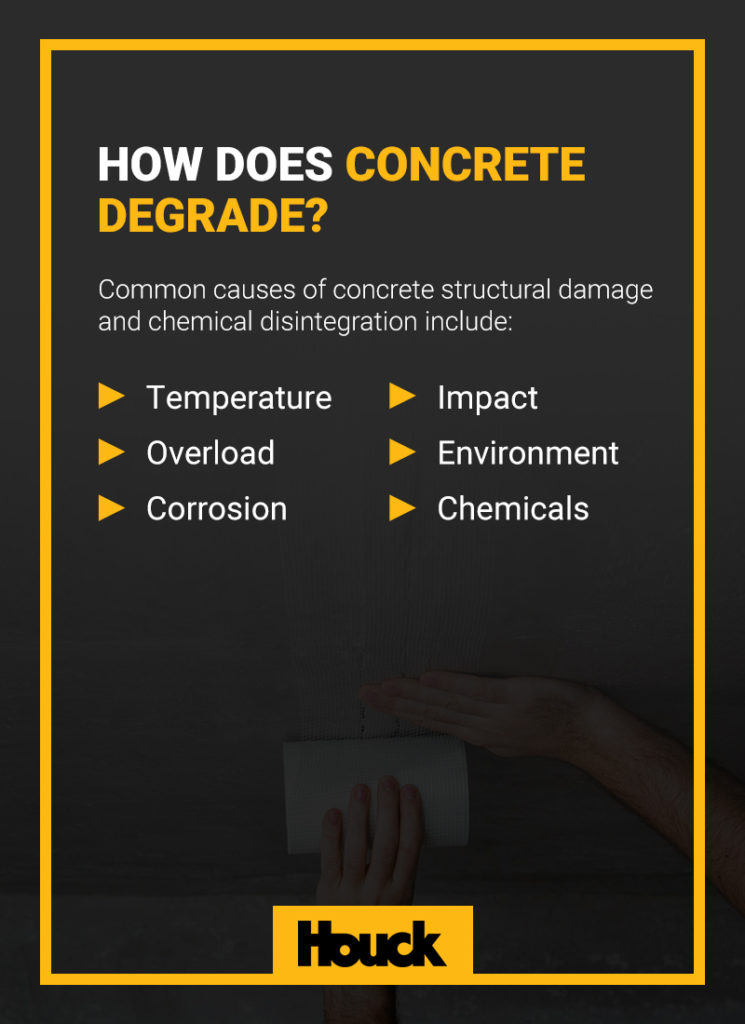
How Does Concrete Degrade?
Quality concrete provides a stable, durable and supportive surface or enclosure, but many outside factors can cause premature aging and degradation.
Common causes of concrete structural damage and chemical disintegration include:
- Temperature: Though concrete can withstand high temperatures, extreme hot and cold or constant fluctuating between extreme temperatures wears it down, especially when moisture is involved. As water pools on worn concrete, it can settle in cracks and holes. If the water freezes, it expands up to 9% which can severely weaken the concrete.
- Overload: Overloads caused by excessive weight leads to buckling, warping, cracking and chipping. It’s a significant concern for concrete in structural joints, foundations and high-traffic areas, like parking garages, roadways and pedestrian walkways.
- Corrosion: Natural aging — including fading and general signs of wear — comes from frequent use and exposure. Corrosion happens from repeated elemental exposure, like hydraulic wear, or when embedded materials, like metal, begin to corrode and cause the surrounding concrete to deteriorate with it.
- Impact: Accidental and unnatural damage can degrade concrete quickly — and unexpectedly. Examples include blasting, fires and impact caused by vehicles, machinery or tools. Impact extent can range from minor to severe and lingering after-effects, like open cracks, make the remaining cement vulnerable to more damage if left unrestored.
- Environment: Earthquakes, seismic tremors, saltwater and tornadoes are unpreventable, and even the strongest concrete surfaces and buildings are at risk. These environmental conditions can make concrete become unlevel or cause extreme cracking and shifting that worsens.
Chemicals: De-icing salts, chemical sulfates, industrial waste, food and beverages and acids create chemical reactions when exposed to concrete surfaces. This reaction can cause instability and cosmetic wear, and it weakens the concrete after significant exposure.
| Contact Us | Call Us |
When to Call a Concrete Restoration Contractor
Prompt concrete restoration saves time, money and frustration — but how do you know when it’s time to schedule an appointment? Inspect your concrete structure or surface for the following signs:
- Cracks: Cracks range from thin, hairline markings to large crevices along walls and flooring. Factors like shrinkage and settling cause several types of cracks, and they range in severity. Even minor cracks can create an uneven walking surface or reduce your facility’s energy efficiency. Cracks may give insects and moisture a way into your building as well.
- Discoloration: Discoloration includes stains, faded areas, minor surface corrosion and tire markings that don’t pose a structural threat but diminish your facility’s appearance. Though not as time-sensitive as other types of damage, it doesn’t look as professional as clean, finished concrete.
- Flaking: Flaking is a type of slow chipping that creates a layer of fine, dust-like concrete on top of affected surfaces. This dust is messy and extremely hazardous to inhale when it produces crystalline silica.
Spalling: Spalling is when the concrete’s surface starts breaking off into small or large pieces. It often happens in high-traffic areas, where it creates bumps and uneven surfaces. - Unevenness: Surfaces are usually uneven for one of two reasons — improper installation or concrete deterioration. Either way, uneven and sunken surfaces cause water to pool, creating an unsafe environment when it freezes. This freezing can also initiate the freeze-thaw cycle, which hastens the erosion process. Unlevel concrete surfaces do not offer long-lasting support and may cause extensive damage in structural applications.
- Gaps: Gaps occur between concrete joints and at the edge of sidewalks and patios. Many factors contribute to gapping, including soil erosion or movement, seismic tremors and impact-related damage.
- Energy: If your facility’s energy costs are higher than usual and you’re unsure why it might be time to inspect your concrete surfaces and supports. Compromised insulation will reflect on your utility bill and could create environmental changes, like hot and cold patches through the room.
Never ignore seemingly minor signs of concrete damage. These issues threaten the integrity of your property and may pose a serious threat to employees and pedestrians. They can also worsen quickly, creating more lasting, challenging defacement.
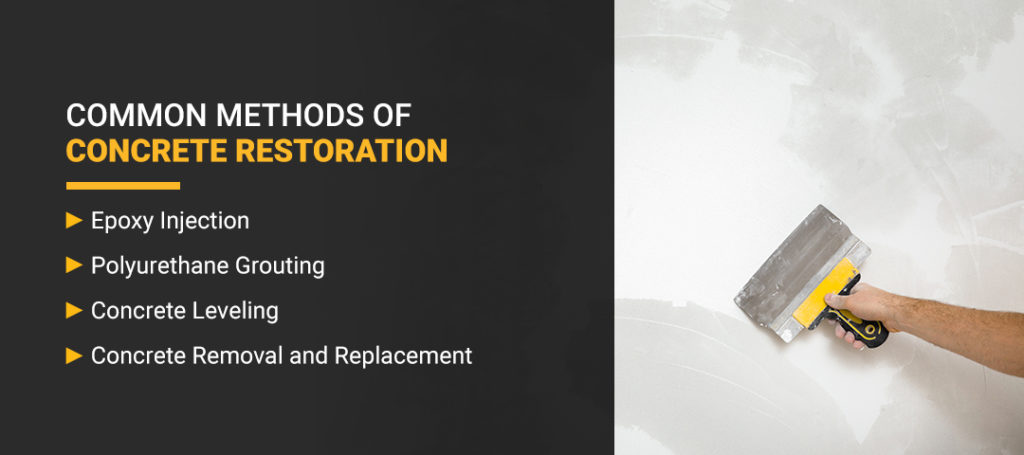
Common Methods of Concrete Restoration
Once you’ve decided concrete restoration is best for your property, your contractor will help you determine which method is suitable for your specific concerns. Four common restoration methods include epoxy injection, polyurethane grouting, leveling and total removal or replacement.
1. Epoxy Injection
Epoxy injections are one method for treating cracks and some gaps. Epoxies create a strong bond that can help a weakened surface continue bearing heavy loads. It’s one of the most minimally invasive and cost-efficient concrete restoration methods available, but there are limitations.
Epoxy injection does not work on moving cracks, and it is not a substitute for correcting whatever caused the crack in the first place. Unless you address the larger issue, you will need additional epoxy injections in the future as cracking continues. Epoxy is also incompatible with moisture, so you must first repair and dry any leaks or high-humidity areas where cracks are present.
2. Polyurethane Grouting
Like epoxy, polyurethane grouting is a restorative resin used for heavy-duty concrete damage. It’s lightweight, fast-acting and minimally invasive, and it’s ideal for challenging or high-traffic applications. Because it’s clean and the cure time is minimal, you can usually resume normal activities shortly after application, assuming you’ve repaired the root cause of the problem.
Unlike epoxy injections, polyurethane grouting can resist wet or dirty conditions without interfering with performance. It is not a structural repair, however, and may not last under extreme tension.
3. Concrete Leveling
Concrete leveling involves raising the surface from underneath when it has started to sink or separate. You might have heard the process called raising, leveling or slabjacking.
Completing the concrete leveling process includes the following steps:
- Drilling holes into the concrete slab or platform to create an opening to the terrain underneath.
- Filling the affected area with polyurethane foam or filler substance — such as limestone and slurry — to even out the concrete’s surface.
- Filing and smoothing the application holes with new concrete.
Concrete leveling is less invasive and more cost-efficient than removal and replacement. It is a good option for property owners who have extensive sloping but do not or cannot invest in removing and replacing the existing concrete.
4. Concrete Removal and Replacement
Total removal and replacement are often the last resort when concrete is damaged beyond repair or restoration. In some cases, replacement may be the more cost-effective, safe or time-saving option if the alternative is several smaller restoration or repair processes.
It’s also the best option if concrete damage is a threat to a building’s structural integrity or when it no longer functions properly. For example, a concrete parking garage floor with multiple large cracks, gaps and sinking is no longer accessible for vehicles and is too far gone for restoration — replacement may be necessary. Do not attempt to remove or replace large-scale concrete without professional assistance.
| Contact Us | Call Us |
Will You Need Concrete Repair or Resurfacing?
Concrete patching, injections and leveling, can address several of your property’s needs. Resurfacing is similar to repairs because the process can correct damages, but instead of individual repairs, it involves removing your concrete’s surface level and pouring fresh in its place.
Resurfacing may be the best option for your property if:
You have multiple concerns on the same concrete surface — i.e., a combination of cracks, gaps, chips and staining.
It would be more cost-effective than multiple surface-level repairs.
When your primary objective is to freshen up the concrete’s appearance.
This process is only effective for top-layer concerns and will not help with deep foundational issues or reoccurring problems, like weathering. A professional contractor can identify the extent of your concrete issues to determine the best course of action. They can also calculate specific costs and advantages to help you make the best choice for your facility and budget.
About Concrete Restoration Services From Houck
Houck can help whether you’re dealing with extensive concrete damage interfering with your daily operations or want to create a more professional appearance for your facility. Concrete rehabilitation from Houck includes repair, restoration or resurfacing for your commercial or industrial property.
Our specialties include expansion joints, epoxy injections and polyurethane grout injections to correct cracks, gaps and natural degradation. We work with clients across Harrisburg, Lancaster, York and the mid-Atlantic region to assess your concrete needs and deliver top results backed by decades of experience and an unwavering commitment to safety.
